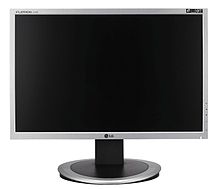16:10 aspect ratio

16:10, also known as 8:5 is an aspect ratio mostly used for computer displays. It represents a ratio of 1.6:1.
Since 2003 16:10 has been a common ratio for sold laptops and LCD monitors. In 2008 16:10 became the most common sold aspect ratio for LCD monitors and the same year 16:10 was the mainstream standard for laptops and notebooks.[1] In later years 16:10 has been replaced by 16:9 as the most common common ratio for monitors, laptops and notebooks.[2][3]
History
Industry moves towards 16:10
Until about 2003, most computer monitors had a 4:3 aspect ratio and some had 5:4. Between 2003 and 2006, monitors with 16:10 (8:5) aspect ratios became commonly available, first in laptops and later also in standalone monitors. Reasons for this transition were productive uses for such monitors, i.e. besides widescreen movie viewing and computer game play, are the word processor display of two standard letter pages side by side, as well as CAD displays of large-size drawings and CAD application menus at the same time.[4][5]
In 2008 16:10 took over the position from 4:3 as the most sold aspect ratio for LCD monitors. At the time 16:10 also had 90 percent of the notebook market and was the most common used aspect ratio for laptops.[2]
Industry moves away from 16:10
In 2008 the computer industry started to move over from 16:10 to 16:9. According to a report by displaysearch the reasons for this were/are:
- Innovative product concepts drives a new product cycle and stimulating the growth of the notebook PC and LCD monitor market.
- 16:9 provides better economic cut (panelization) in existing TFT LCD fabs.
- 16:9 products provide higher resolution and wider aspect ratio.[6]
- The widespread adoption of High Definition in the consumer entertainment sector will help end users readily adopt the new products with the wider aspect ratio.
- The 16:9 panels provide an opportunity for PC brands to further diversify their products.[2][3]
In 2011 Bennie Budler, product manager of IT products at Samsung South Africa, confirmed that monitors capable of 1920x1200 resolutions aren't being manufactured anymore. “It is all about reducing manufacturing costs. The new 16:9 aspect ratio panels are more cost effective to manufacture locally than the previous 16:10 panels”[7]
In March 2011 the 16:9 resolution 1920x1080 became the most common used resolution among Steam users. The earlier most common resolution was 1680x1050 (16:10).[8]
16:10 - properties
According to manufacturer NEC: "The vision of humans naturally moves horizontally rather than vertically, and ergonomics experts have recommended a broad format for a long time. In a professional setting, the use of large screens better facilitates execution of the tasks on the screen and thus contributes to increased productivity." [9]
The 16:10 ratio, at 1.6, is close to the golden ratio (1.618, often denoted φ).
Common screen resolutions of 16:10 screens
| Name | Dimensions | Diagonal screen size |
|---|---|---|
| WXGA | 1280×800 | 13–15 in (33–38 cm) |
| WXGA+ | 1440×900 | 15–19 in (38–48 cm) |
| WSXGA+ | 1680×1050 | 20–22 in (51–56 cm) |
| WUXGA | 1920×1200 | 23–28 in (58–71 cm) |
| WQXGA | 2560×1600 | 30 in (76 cm) |
See also
- Display aspect ratio - Different aspect ratios for computer monitors.
- Aspect ratio (image)
- Computer display standard
References
- ^ http://lowendmac.com/musings/08mm/10-percent-notebook.html
- ^ a b c http://www.displaysearch.com/cps/rde/xchg/SID-0A424DE8-28DF6E59/displaysearch/hs.xsl/070108_16by9_PR.asp
- ^ a b http://www.engadget.com/2008/07/02/widescreen-lcds-going-widescreen-by-2010/
- ^ NEMATech Computer Display Standards http://www.millertech.com/Technical_Specs.htm
- ^ "Introduction--Monitor Technology Guide". necdisplay.com. Archived from the original on 2007-03-15. (currently offline)
- ^ http://www.displaysearch.com/cps/rde/xchg/SID-0A424DE8-28DF6E59/displaysearch/hs.xsl/070108_16by9_PR.asp
- ^ http://mybroadband.co.za/news/hardware/17621-Widescreen-monitors-Where-did-1920x1200.html
- ^ http://store.steampowered.com/hwsurvey
- ^ NEC Display Solutions - Ecrans LCD au format large
